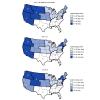Seasonality of Respiratory Syncytial Virus - United States, 2017-2023
- PMID: 37022977
- PMCID: PMC10078848
- DOI: 10.15585/mmwr.mm7214a1
Seasonality of Respiratory Syncytial Virus - United States, 2017-2023
Abstract
In the United States, respiratory syncytial virus (RSV) infections cause an estimated 58,000-80,000 hospitalizations among children aged <5 years (1,2) and 60,000-160,000 hospitalizations among adults aged ≥65 years each year (3-5). U.S. RSV epidemics typically follow seasonal patterns, peaking in December or January (6,7), but the COVID-19 pandemic disrupted RSV seasonality during 2020-2022 (8). To describe U.S. RSV seasonality during prepandemic and pandemic periods, polymerase chain reaction (PCR) test results reported to the National Respiratory and Enteric Virus Surveillance System (NREVSS)* during July 2017-February 2023 were analyzed. Seasonal RSV epidemics were defined as the weeks during which the percentage of PCR test results that were positive for RSV was ≥3% (9). Nationally, prepandemic seasons (2017-2020) began in October, peaked in December, and ended in April. During 2020-21, the typical winter RSV epidemic did not occur. The 2021-22 season began in May, peaked in July, and ended in January. The 2022-23 season started (June) and peaked (November) later than the 2021-22 season, but earlier than prepandemic seasons. In both prepandemic and pandemic periods, epidemics began earlier in Florida and the Southeast and later in regions further north and west. With several RSV prevention products in development,† ongoing monitoring of RSV circulation can guide the timing of RSV immunoprophylaxis and of clinical trials and postlicensure effectiveness studies. Although the timing of the 2022-23 season suggests that seasonal patterns are returning toward those observed in prepandemic years, clinicians should be aware that off-season RSV circulation might continue.
Conflict of interest statement
All authors have completed and submitted the International Committee of Medical Journal Editors form for disclosure of potential conflicts of interest. No potential conflicts of interest were disclosed.
Figures


References
-
- Havers FP, Whitaker M, Pham H, et al. 2209. RSV-associated hospitalizations in adults aged ≥18 years and the impact of the COVID-19 pandemic in the United States, October 2018–February 2022. Open Forum Infect Dis 2022;9(Suppl 2):ofac492.1828. 10.1093/ofid/ofac492.1828 - DOI
MeSH terms
LinkOut - more resources
Full Text Sources
Medical
Miscellaneous

